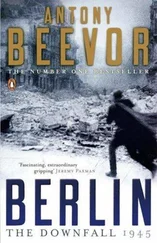The Army Group commander’s energy produced mixed feelings in many unit commanders. All the time spent on improving the defences had left fewer opportunities for training. They also suffered from a shortage of ammunition for range practice, which may well have contributed to the generally bad marksmanship of many German units. Rommel also insisted on a dramatic increase in the number of minefields. A British officer heard later from prisoners that many of the dummy minefields had in fact been marked out on the orders of German officers purely to impress their demanding commander-in-chief. They had assumed that he would not poke about too much to check that they were real.
In theory, Rundstedt’s command included one and a half million members of the Wehrmacht, although he had no control over the Luftwaffe and Kriegsmarine. The army units, with 850,000 men all told, were of very mixed quality. Of the thirty-six infantry divisions, just over half had no transport or mobile artillery. These were mainly the formations allotted for coastal defence. Some even included ‘ear and stomach battalions’, composed either of soldiers who had suffered stomach wounds or — a truly surreal notion when it came to giving orders in battle — of those who had lost their hearing.
Many of the Germans in other infantry divisions in France were either comparatively old or else very young. The writer Heinrich Böll, then an Obergefreiter in the 348th Infanterie-Division, wrote, ‘it is really sad to see these children’s faces in grey uniforms’. The infantry had also suffered, because the best recruits were sent to the SS, the Luftwaffe paratroop divisions or the panzer corps. ‘No good replacements were ever sent to the infantry divisions,’ observed General Bayerlein. ‘That is one reason why good panzer units had to be kept in the front line for an excessive time.’
Numbers on the western front had also been made up with conscripts from Alsace, Lorraine and Luxembourg, as well as those defined as Volksdeutsch. These included men deemed to be of German extraction born in central Europe from the Baltic to the Black Sea, even though few of them spoke or understood the language. Poles had also been forcibly conscripted.
Around one-fifth of the troops in the Seventh Army command were Poles by birth or Osttruppen — eastern troops recruited from Soviet prisoners of war. Many had volunteered only to save themselves from starvation or disease in German camps. Their deployment on the eastern front had not been a great success, so the Nazi regime had withdrawn them gradually, to be incorporated into General Andrei Vlasov’s ROA, or Russian Liberation Army. Most had then been sent to France. They were organized in battalions, but the German attitude to Slav Untermenschen changed little. As in the occupied territories of the Soviet Union, they were often used in anti-partisan operations. Generalfeldmarschall von Rundstedt approved of the idea that their presence and tendency to loot would create an ‘apprehensive impression about the invasion of France by the Soviet army’.
German officers and NCOs who commanded them were anxious about being shot in the back by their own men once the fighting started. A number of these Osttruppen deserted to French resistance groups. Many surrendered to the Allies at the first opportunity, but a second change of side would not save them from Stalin’s revenge at the end of the war. In any case, German attempts to stiffen their morale with hatred of the western Allies — the ‘ Plutokratenstaaten Amerika und England ’- proved a failure. Only a couple of units, such as the Ostbataillon Huber, were to fight effectively in the battle to come.
For French civilians, the Osttruppen presented an unusual sight. A citizen of Montebourg on the Cotentin peninsula, a town which was to experience heavy fighting, watched in amazement when a battalion of Georgians marched down the main street behind an officer mounted on a grey horse. They were singing an unfamiliar song, ‘very different to the usual “Heidi-Heidi-Hos” which had rung in our ears since 1940’.
The French, who sometimes referred to the Volksdeutsche as ‘booty Germans’, showed most sympathy towards the conscripted Poles. One woman in Bayeux heard from Poles in the German army that word had spread secretly from Warsaw that they should surrender to the Allies as soon as possible and then transfer to the Polish army of General Anders, fighting with the British. These Poles also spread word to the French of the SS extermination camps. Their existence was not always believed, particularly if accompanied by garbled details, such as a story that Jewish corpses were rendered into sugar. These Poles also foresaw the fate of their own country as the Soviet armies advanced. ‘You will be liberated,’ they said to the French, ‘but we will be occupied for years and years.’
In stark contrast to the weak infantry divisions were the panzer and panzergrenadier divisions of the Waffen-SS and the army. Generalleutnant Fritz Bayerlein, one of Rommel’s officers from North Africa, commanded the Panzer Lehr Division, whose cadres were based on the staff from the armoured training establishments. When he took over, Guderian told him, ‘With this division on its own you must throw the Allies into the sea. Your objective is the coast — no, not the coast — it is the sea.’
Other full-strength armoured divisions which would fight in Normandy included the 2nd Panzer-Division under Generalleutnant Heinrich Freiherr von Lüttwitz, a tubby man with a monocle. Rommel trusted him enough to open negotiations with the Allies, if the need arose. The armoured formation closest to the Normandy coast was the 21st Panzer-Division, which would face the British in front of Caen. Equipped with the Mark IV tank, rather than the latest Panthers or Tigers, a sixth of its personnel consisted of Volksdeutsche. According to their commander, Generalleutnant Edgar Feuchtinger, they ‘could hardly understand orders and could hardly be understood by their NCOs and officers’. Feuchtinger was a convinced Nazi who had helped organize the Berlin Olympics of 1936. Unadmired by his colleagues, he was also a philanderer. On the night of the invasion, he was with his mistress in Paris.
Those fighting in Normandy, especially in the British sector on the eastern flank round Caen, would see one of the greatest concentrations of SS panzer divisions since the Battle of Kursk. There would be the 1st SS Panzer-Division Leibstandarte Adolf Hitler ; the 12th SS Panzer-Division Hitler Jugend , which contained the youngest and most fanatical troops of all, and then later, when they were transferred from the eastern front, the 9th SS Panzer-Division Hohenstaufen and the 10th SS Panzer-Division Frundsberg . British armour would also encounter two SS Tiger battalions, with devastating consequences. The American forces to the west would find themselves facing only the 17th SS Panzergrenadier-Division Götz von Berlichingen , the weakest and worst trained of all the Waffen-SS formations in Normandy, and the 2nd SS Panzer-Division Das Reich , which was soon to become even more infamous for its brutality. But the Americans would come up against many more infantry divisions. Of these, General der Fallschirmtruppen Eugen Meindl’s II Paratroop Corps would prove the most formidable.
The commander of LXXXIV Corps, which controlled the Normandy sector, was General der Artillerie Erich Marcks, a highly respected and intelligent leader. Thin and wiry, he had lost one eye in the First World War and a deep scar ran across his nose and cheek. The bespectacled Marcks had also lost a leg earlier in the Second World War. ‘He was of Spartan-like, old Prussian simplicity,’ wrote one of his admiring officers. On one occasion, when whipped cream was served at dinner, he said, ‘I do not wish to see this again as long as our country is starving.’
Читать дальше











